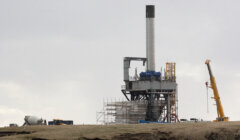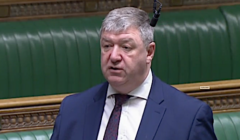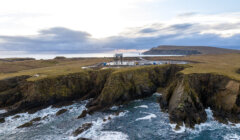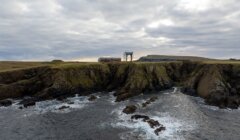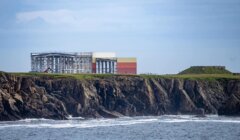Business / Economic benefits outweigh rocket emissions, launch providers say
THE COMPANIES behind future launches at the proposed SaxaVord Spaceport say the economic benefit of operations in Unst will outweigh the environmental impact.
The emissions from the rocket due to be used for the first launch will be equivalent to the annual output from a “handful of automobiles”, a media briefing heard on Thursday.
The environment is an increasingly hot topic at the moment with the COP26 climate conference in Glasgow looming next month amid Scotland’s desire to go net zero by 2045.
But the president of rocket supplier ABL, Dan Piemont, said satellite launching is “one of the most efficient ways to turn emissions into economic output”.
“When you think about the economic impacts of a space launch, when you’re got a 12 million dollar rocket, you’ve got a multimillion dollar satellite, you’re getting 10 million pounds or more of economic value for the emissions profile of something that would typically come with much less economic value,” he added.
Nik Smith from aerospace giant Lockheed Martin, which will also be involved in the first launches, added that some satellites due to head skywards from Unst will be likely to monitor climate change. “That cost benefit easily is in favour of doing this activity,” he said.
He added that as a result the COP26 conference is actually driving more interest in the UK becoming a space nation.
SaxaVord Spaceport chief operating officer Scott Hammond meanwhile described the environmental impact assessment undertaken through the planning process as “very fulsome”, which covered areas like air quality, CO2 emissions, noise, ecology and marine life.
“From our site one of the big advantages for us is we have very, very little peat,” he added.
“In some areas the top soil is only about 500 mil deep and then we’re straight onto granite.”
Become a member of Shetland News
Meanwhile the first launch from Unst is expected to take place next year, possibly in the summer.
But the team still has to secure planning permission, while it aims to get a spaceport licence application submitted by the end of the year.
“Our aspiration is to make it as early in ’22 as possible,” Smith said.
“We know there’s probably going to be some conditions that have an impact on when that will be after, but I think we’re looking probably after summer some time in ’22. That’s what we think is going to be most likely at the moment.”
Hammond said the team expects a planning condition from NatureScot for no launches between mid-May and the end of June during the bird nesting season.
He added that the spaceport has had “very positive” talks with Historic Environment Scotland over its objection to rocket launches from the former radar base at Lamba Ness. The appeal against the refusal is currently on hold.
This week meanwhile marked the first visit of ABL Systems to Unst to check out the proposed spaceport site.
The US company will provide rocket services for the UK government-backed Pathfinder project. It aims to oversee the first vertical satellite launch from UK soil in Unst.
Piemont said Britain’s most northerly island was the “ideal place” for rocket launches.
SaxaVord Spaceport CEO Frank Strang added: “We’re delighted to welcome ABL to Unst for the first time and to welcome back Lockheed Martin as we prepare for the UK Pathfinder launch next year.
“The project has real momentum now and these engagements are a vital part of our preparation for delivering the UK’s first vertical satellite launch.”
When questioned during a media briefing on Thursday if any future satellite launches would be for military purposes, the companies reiterated that SaxaVord will be a commercial spaceport and therefore needs a variety of customers.
“Anyone who comes here will be a commercial paying customer,” Smith said.
“In the same way that you may get a government agency using Royal Mail or DHL or deliver parcels, it’s the same thing.”
There is plenty of funding behind the Pathfinder project, which has received a commitment worth more than £20 million from the UK Government.
Lockheed Martin was originally going to carry out the project at the proposed spaceport in Sutherland, but in 2020 it switched its support to Unst.
The launch will use ABL’s new RS1 rocket, which is said to be 88ft in height and able to carry payloads of up to 1,350kg.
UK Space Agency’s spaceflight grants manager Kelmend Kavaja said: “We are working closely with national and international partners to bring the first satellite launches to the UK in 2022, deliver on the National Space Strategy and create hundreds of new jobs.
“It’s great to see the SaxaVord Spaceport, Lockheed Martin and ABL Space advancing their plans to deliver sustainable, commercial spaceflight operations from the Shetland Islands.”
It is estimated that the SaxaVord launch facility will eventually create around 140 jobs in Unst and inject at least £4.9 million per annum into the island’s economy, with 70 more jobs expected throughout Shetland.
Become a member of Shetland News
Shetland News is asking its readers to consider paying for membership to get additional perks:
- Removal of third-party ads;
- Bookmark posts to read later;
- Exclusive curated weekly newsletter;
- Hide membership messages;
- Comments open for discussion.
If you appreciate what we do and feel strongly about impartial local journalism, then please become a member of Shetland News by either making a single payment, or setting up a monthly, quarterly or yearly subscription.





































